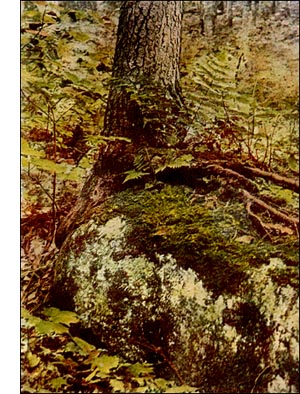Ohio Hairy Cap Moss
 Ohio Hairy-cap, Polytrichum Ohiense, Ren. and Card.
Ohio Hairy-cap, Polytrichum Ohiense, Ren. and Card.Habit and habitat.-Found on the ground growing loosely in patches. Distinguished from P. formosum by the form of the spore-case, which is more or less narrowed toward the base and has an indistinct apophysis, but chiefly distinguished by the form of the marginal cells of the lamellae, a character which separates it from all our other species of Polytrichum.
Name.-The specific name Ohiense refers to the fact that the type specimen came from Ohio.
Plant (gametophyte).--Erect, simple or divided, 1 1/2 to 3 inches high, woolly below.
Leaves.-Spreading when moist, erect and slightly twisted when dry; apex narrowly taper-pointed, the awn spiny; base white, sheathing; margin serrate; lamellae 30 to 40; cells 5 to 7 deep, the marginal cell much larger, broader than high, stirrupshaped in section.
Leaves at the base of the pedicel (perichaetial leaves).--Resembling the stem-leaves, longer and with a longer transparent base.
Habit of flowering.-Male and female flowers on separate plants (dioicous).
Veil (calyptra).-Pale, small, ragged, not concealing the spore-case.
Spore-case.-Erect, finally horizontal, with 4 to 6 acute angles, the base tapering into an indistinct apophysis.
Pedicel (seta).-Red below, paler above, a to 4 inches long.
Lid (operculum).-Conic and taper-pointed, bordered with orange.
Teeth (peristome).-Sixty-four.
Spores.-Rust colour, ripe in summer.
Distribution.-North Carolina to Prince Edward's Island, and west to Minnesota and British Columbia. Also in Norway and Sweden.